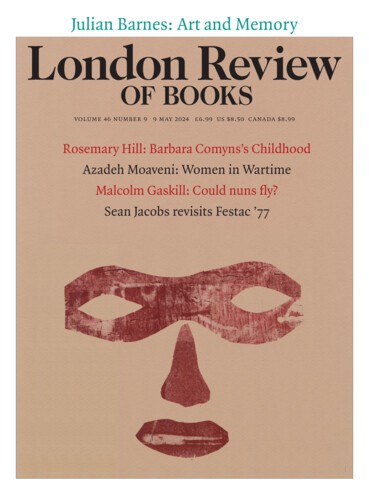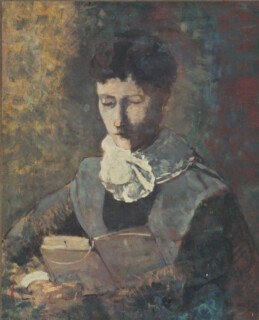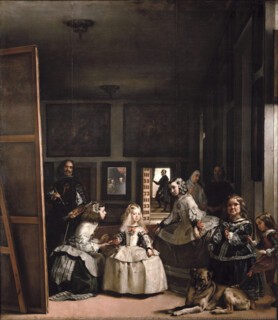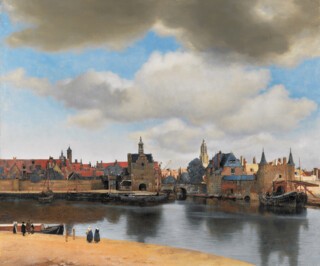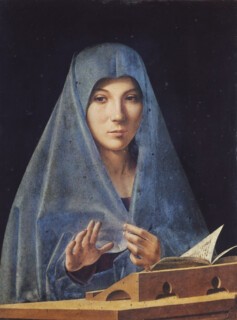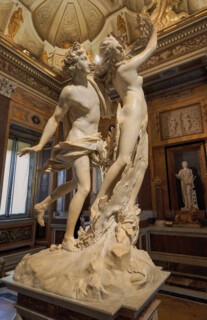About fifteen years ago, I bought a painting at auction. Apart from the usual anxieties, there was an overriding emotional factor. My wife, who had died a year or so earlier, had for many years collected images of women reading: mainly drawings, prints and watercolours, plus one small painting. I was browsing through the online catalogue of a French sale when I was stopped by two pictures by Odilon Redon, both of his wife, Camille, reading: one was predominantly pale green, and showed her sitting in the middle distance in a garden; the other, predominantly red and purple, showed her in close-up, with elongated features and eyes cast down on her book. Redon was famously uxorious, and painted Camille constantly over a period of thirty years. He once wrote:
You can tell the nature of a man from his companion or his wife. Every woman explains the man by whom she is loved, and vice versa – he explains her character. It is rare for an observer not to find between them a host of intimate and delicate connections. I believe that the greatest happiness will always result from the greatest harmony.
He wrote this not as a doting husband, but nine years before he met Camille Falte. He said that no decision he took as an artist was as clear and unshadowed by doubt as when he said ‘yes’ on his wedding day.
It seemed clear to me that buying one of these two portraits would be a fitting way to complete my wife’s collection. They were happily not as desirable to art buyers and investors as, say, Redon’s famous noirs or his flower paintings; so they were affordable. And more so, I assumed, by being of a subject he had painted many times. But which of them did I want, and which was I more likely to get? I preferred the purpley close-up, but would have been happy with the sylvan scene. And here the jeopardy of the auction room kicked in. The problem was that the pictures were coming up in the wrong order. If the purple one had come up first, and I was outbid, then I would have settled for the green one. But the green one came up first. What if I passed on it, and was then outbid on the purple one? I didn’t want, and couldn’t afford, both. What if I ended up with neither?
I signed up to bid online, and logged in on the appointed day. There is a specific excitement and nervousness about bidding in this way. There are three types of bidder: those online like me; those on the telephone; and those in the room itself, some of whom you can see. Your rivals, your opponents, could be anywhere in the world: you naturally imagine them lolling about in a penthouse suite in a different time zone, filthily rich and filthily intent on thwarting you. But there is also a chumminess about the process. Auctioneers (apart from taking ‘chandelier bids’ from non-existent people) like to flatter, cajole, joke, wheedle, even beg: it is all part of their professional training. Whatever they sell, and whatever you buy, they are pleased for you. As Wilde put it, ‘it is only an auctioneer who can equally and impartially admire all schools of art.’ So he or she will congratulate – and if the price is really high, thank – the successful bidder. My favourite memory of what can be a fraught business came when I was bidding online for some photographs in a provincial French auction. At the moment I saw off the (very few) rival bidders, the auctioneer brought down his hammer, beamed into the camera, pointed at me and cried: ‘C’est l’Angleterre!’
The lot numbers ticked down towards the two Redons, with my forefinger hovering over the mouse. The green one first: the auctioneer imagined some bids, looking around hopefully until he reached the picture’s reserve, and after a wait uttered the French equivalent of ‘pass’, indicating that the work had gone unsold. In the brief moments that followed, I naturally decided that my unseen rivals were saving their money for the better picture. Again, the urgent patter of theoretical bids, then the expectant pause just below the low estimate. Well, I thought, I may as well start things off, and clicked on the ‘bid’ button. And waited; and waited. But I was the sole bidder, and the auctioneer was duly grateful to me. I was filled with a prideful exultation: uxoriously, I had completed my wife’s collection.
I paid, arranged shipment and awaited the arrival of Mme Redon. When she turned up, I received an unpleasant surprise, which made me think about the way we look at images of art, and what the brain does with them. I had seen the picture in an online catalogue, its size there at most about three inches by two. It had not been held up and shown to bidders in the room and online during the sale. I had imagined it as being a taut, concentrated picture of about ten or twelve inches by six or eight. Of course, the actual dimensions were printed in the catalogue, but I had paid them no attention because I knew the picture’s size, its exact, ideal size, without checking: it was a size which fitted in with the rest of my wife’s collection. And then the parcel arrived, and to my dismay I saw that it was larger, quite a bit larger, than I had presumed. I left it wrapped for several days. And when I finally opened it, I was shocked. Twenty inches by sixteen: almost double my top assumption. This was wrong in two ways: the image was too big, too loose, too impressionistic. And adding this biggish painting to a collection of on the whole smallish images felt bossy. I didn’t like it, and my hoped-for coup had turned out a failure because of my own stupidity. I hung it on the wall with some reluctance.
Buying a work of art is often an instinctual business: you see it, you like it, it speaks to you and you may or may not think about its ‘true’ worth, as opposed to its worth to you. No wonder the rich have art advisers to guide and reassure them, not only that they have made an excellent purchase (and the adviser an excellent commission) but that, even if the collector subsequently goes off the work, it will still have retained, if not increased, its value. Needless to say, I didn’t have any such back-up. And I decided, instinctively, that Redon had painted his wife the wrong size. It would have been much better if he had painted her half or a third smaller, which I knew to be perfect. However – and fortunately – over a period of time, I realised the absurdity, if not borderline insanity, of the belief that I knew better than Redon how he should have painted his own wife. And over the coming weeks I began to look at the picture for itself. Mme Redon was sitting in a background swirl of colours: old gold, brown, magenta, blue. Beneath her grave lectorial face was a sharply white jabot, itself the centre of the picture around which the colours played. These were sombre: Redon was concentrating unfrivolously on his wife just as she was concentrating on her book. And then, suddenly, I saw where he had signed his homage: in tiny capital letters on one of her fingers which grasped the book. It was almost a secret signature. Somehow, this clinched things, and in half-embarrassed conclusion I agreed that the painter, and the husband, knew exactly what he was doing.
This falsifying of expectation hadn’t happened to me before (except, of course, in the general area of life). It made me reflect on the distorting distance that can invade between image and reality; between what we think we see, or hope to see, and what is really there; also, more widely, on how the reproduced image can hamper the way we look at art. And this image of a wife made me think of all those ambassadors who travelled to kneel before foreign kings bearing a miniature portrait of some princess of the realm whose parents intended her for marriage abroad. What instructions might have been given to the painter in these diplomatic sales pitches (make her look modest, concentrate on the eyes, minimise the squirrel chin, highlight the expensive jewellery)? How might the king assess his putative bride on the basis of a few square inches of paint? Further, how pleased or disappointed might he be when his princess finally arrived and he saw her in the flesh? Were some of them sent back, like unwanted Amazon goods?
More common than the falsifying effect of anticipation is the falsifying of memory. Thirty or so years ago, I spent a semester teaching at Johns Hopkins University. On its campus is the Baltimore Museum of Art, which I used to visit about once a week. Among the many Matisses and Picassos was a small painting by an artist whose name and work were unfamiliar. Félix Vallotton’s The Lie is an intense scene of sexual or emotional betrayal in burning shades of red and black, yellow and brown. It is forceful yet enigmatic, and stayed with me powerfully. About ten years later, I saw it again, this time in its native Switzerland, in a retrospective of Vallotton’s work. I was genuinely shocked by how small it was – indeed, the smallest picture in the whole show. Its radiance in my memory must have swelled it to about four times the size of what was now in front of me.
We think we remember works of art rather well; and probably assume that the greater the work of art, and the more powerfully it strikes us, the more accurate our mental image of it must be. Maybe this is the case with professional art historians: I assume that they have – must have – a better visual memory than amateur art-lovers, and perhaps even artists. After all, literary critics in my experience have a better memory of books than most readers, and better even than that of many writers (and they have certainly read more than the average novelist, whose gaps are sometimes shocking). But memory is such a shifty and shifting process, constantly duping us. As far as it is possible to generalise, I think we misremember small pictures as being larger than they are, and large pictures as smaller. Also, what we are remembering is not just the painting itself but its effect on us; and some parts of it will inevitably remain fresher than others. At least, in this age of mass colour reproduction, we can always check our memories – or so we believe. In my early decades, going to an art gallery abroad always culminated in a good deal of time spent at the postcard carousels; and over the years I have accumulated a vast collection of cards which I can use to check my memory. This ‘check’ can only be partial, however: there is the question of size (how accurately can and do we scale the image up?) and also of colour fidelity. I have a friend who, when she first started looking at art, would never buy a postcard of a painting she admired, for fear that the original would be supplanted in her memory. This was properly high-minded, but in practice, she reported, her remembered images were still subject to normal deterioration.
Postcard-sending has become a greatly diminished pastime: museum gift shops earn more money from, and hence give more space to, art-themed scarves, children’s games, van Gogh mugs and repro jewellery. The decline of the postcard is of course intimately linked to the rise of the iPhone, which allows you to make your own postcards and send them worldwide without a stamp. Most galleries allow their use – either on principle, or because of the impossibility of policing the crowds who will take pictures willy-nilly; indeed, for some, the very point of a famous work of art is the selfie you take in front of it. The Prado is the only major museum I’ve been to where camera use is strictly prohibited. There is also a seductive danger in the mobile phone shot: you can frame and reframe it as you like – and, more perniciously, you can alter the colours. I’ve never seen anyone doing so while standing next to what they have just photographed; but they do it afterwards, and are therefore adjusting the colours to what looks best to their eye. Though – who knows? – they might actually be pumping up the colours to something closer to what the artist originally produced before those centuries of fade.
Recently, I went to the Prado with the intention of spending as much time as I could in front of Las Meninas, which I had seen twice before. It is positioned so that you can see it through an enfilade of rooms, and slowly approach, gradually discovering (or rediscovering) its enormous size. It’s one of the largest pictures Velázquez ever painted, and also one of the most extraordinary in its visual cunning: stunned spectators may easily find themselves losing authority, becoming victims of the picture – the characters on the canvas seem to be interrogating us, rather than the other way round (even the dog has a quizzing expression). This time, as I came to a halt at a proper distance, I had two immediate thoughts: though monumental, it wasn’t quite as big as I remembered; while the colours of the figures weren’t quite as bright as I remembered. The latter effect was doubtless due to having ‘seen’ it over the last decades only in reproduction, in books and magazines which inevitably tend to glorify the colours (and it may be that the very process of reproducing a detail dissociates that detail from the background and thus makes it feel brighter). These initial responses – they were hardly the size of ‘objections’ – gave way first to the novelising this picture often sets off: what exactly is the story, who is more powerful than whom, who are the figures in the tiny mirror in the far background, and so on. Such novelising isn’t of course confined to novelists; most people do it as a normal reaction to seeing images of other people. Proust, when he went round an exhibition, had a habit of comparing the long-dead subjects of portraits to contemporary figures in Parisian high society. The other thing I noted about Las Meninas was that my memory of it was entirely confined to the bottom half, with its frieze of quizzical figures; what gets forgotten is the upper half of the painting, which is an enormous expanse of – what, exactly? The dark ceiling of the grand room, plus a couple of large, dark, indecipherable pictures hung high up on the back wall. But why does it take up so much space, other than because that was what the room looked like? I hadn’t seen such a large empty – or perhaps otiose – top half to a painting since the huge scumbly area above the action in Courbet’s L’Atelier. I left with my memory of the picture readjusted – until the next time.
Proust called Vermeer’s View of Delft ‘the most beautiful painting in the world’, and made it central to a key scene in À la recherche. He first saw the picture in The Hague in 1902, and then again in 1921 in Paris, when it brought on an attack of dizziness. Vermeer is Swann’s favourite painter; and Proust sends the dying writer Bergotte to see the picture when it comes on loan from The Hague. As Bergotte approaches it, he has an attack of dizziness, just like his maker. He fixes his gaze on the piece of yellow wall ‘like a child upon a yellow butterfly he wants to catch’. It seems to teach him a lesson about his own writing, which has always been too spare. ‘I should have applied several layers of colour, made my sentences precious in themselves, like this little section of wall.’ Repeating to himself ‘Little patch of yellow wall, with a sloping roof, little patch of yellow wall,’ he sinks onto a sofa, then rolls off it and expires on the floor of the gallery. However, if you look at the picture in modern colour reproduction (which Proust was unable to do, relying instead on memory, and perhaps notes) it is quite clear that there isn’t a ‘little patch of yellow wall’. There is a little patch of orange wall, surmounted by a sloping yellow roof. We don’t think that Bergotte is confused, because he is in front of the picture at the time. The only explanation is the gap between the painting and Proust’s memory of it.
I am now in my late seventies, and though not obsessively valetudinarian, I’m aware that I might be looking for the last time at some of my favourite pictures. At the end of last year, I was in Palermo, and made a pilgrimage (not an exaggeration) to the Galleria Regionale della Sicilia to see what I might allow a future character in a book of mine to call ‘the most beautiful painting in the world’: Antonello da Messina’s portrait of the Virgin Annunciate. I had seen it once before, about 25 years ago, when I had no idea what to expect, having never knowingly seen a reproduction of this picture. Rather as with the Velázquez, I remember advancing through several rooms, at the end of which a blue vertical oblong was slowly becoming clearer until I stood in front of her. Though irreligious, I have a great attachment to images of the Annunciation, perhaps because (unlike with other Christian scenes and images) it feels possible to project myself back to being a believer in front of this primal image of the moment the world changed for ever. I prefer earlier images, which seem ‘purer’ – the Fra Angelico in Florence’s San Marco is a special favourite. Or those rustic carved wooden figures, made to stand on either side of the altar, in which the Virgin is represented as an innocent village girl, about to enjoy the sort of upward mobility no one had ever imagined before.
Antonello’s Virgin is shown at half-length, seated, with a reading stand in front of her. A rich blue veil covers her head and shoulders, while a deep crimson undergarment peeps through at wrist and chest. Her expression is one of otherworldly calm: she is not surprised at this moment of her destiny; though her hands tell a slightly different story. Her right hand is raised, as if to ward off the angel (not now! not yet!) while her left hand pulls protectively at her shawl. There is a theory that the first two fingers of her right hand are meant to evoke the two fingers which the Angel often points at her in recognition, so that she stands for both Virgin and Angel at the same time (which seems a theory too far to me). In front of her, Antonello has wittily given the angled wooden book-stand and the table on which it rests an attack of woodworm – which has strangely ‘spread’ to the real wooden frame of the picture itself. And there she is, resting, awaiting, by herself, the only figure in the painting. This is an exhilarating, revolutionary act by Antonello: she is staring towards us, so that we are standing where the Angel is standing; she is looking at us both as spectator and as bringer of astounding news. Are there any other Annunciations from which the Angel is missing? I know of only one other, also by Antonello, in Munich, in which the Virgin – not the same model – is slightly more perturbed by the news as she looks past our left shoulder at the arriving Angel. But it seems to be an image unique to Antonello, apart from a jocose Richard Hamilton print of a lounging naked model receiving the news on a mobile phone.
When I saw her again, she wasn’t, as she had been, visible from afar. The picture, and the room, and our arrival into it, and the lighting, had all been redesigned by a local architect. You didn’t see her until you crossed the threshold, and then she was over to your right, in a new, specially designed glass case. The window facing her was lightly covered, but there was now a reflection to cope with. And then there was the size of her. As with my Odilon Redon, though in retrospect rather than prospect, she was somewhat larger than I had expected – probably because my memory was based more on multiple examinations of the postcard, from which I had scaled her up, but not enough. Her veil was a paler blue than in my postcard’s memory; while the sunlit surface of her table, and the page of the book she was reading, were brighter. Also, I decided I had been wrong about the ‘witty’ woodworm in the reading stand: it looked instead as if there had been real woodworm at work on the picture itself over the centuries – there seemed to be other small holes in the Virgin’s veil and elsewhere. Finally, the protective glass inevitably reduced the previous sense of intimacy between spectator and subject. It took some minutes before I could reattach the present reality to the remembered image. But, eventually, as with Las Meninas, I got there.
The Velázquez and the Antonello are examples of smallish misrememberings which disconcert mainly because of a perhaps sentimental expectation that you will recall great paintings more exactly than less great ones (and that their installation will remain unchanged). But my final example is weirder, and much more undermining to one who largely believes that memory of objects – rather than of people, their doings and motivations – is generally reliable. In 2002 I visited the Villa Borghese in Rome, and saw for the first time Bernini’s sculpture of Apollo and Daphne – ‘the greatest sculpture I’ve ever seen’, I wrote in my notebook, followed by ‘Eat your heart out, Canova.’ It depicts the moment when Apollo has just caught and, with his left hand, touched the fleeing Daphne, who in self-defence is turning into a laurel tree. Daphne’s mouth is open in a scream of terror, while Apollo, far from appearing a vile rapist, is portrayed as suave and dashing – in both senses. (The back story is one of malign manipulation by Cupid, who has shot Apollo with a gold-tipped arrow, which kindles love, and Daphne with a lead-tipped one, which puts love to flight.) The two life-size figures are naked, apart from a flowing robe Apollo has over one shoulder and across his loins. But Daphne is in the process of being reclothed by branches and leaves and tree trunk which will protect her from Apollo. Her fingers are turning into leaves, her toes into roots, while bark is growing around her: there is even a fierce clump of foliage protecting her from Apollo’s advancing sexual parts. It is an astounding image of the moment when fierce movement is suddenly frozen in stop-time, in turn depicted in the stop-time of a marble statue. I have seen it twice since, and each time walked around it in simple (and complicated) awe.
But after that first time, something bizarre occurred. Without realising what was happening, the statue, fixed in its being and nature since 1625, began to sprout fiercely in my memory. Barely a couple of years later, two friends were going to Rome, and I urged them to visit the Villa Borghese. There, I told them, they would find Bernini’s amazing sculpture, which fills an entire room. You come on it from behind, with a figure of Apollo pursuing, and then see an entire spreading tree which prevents him from reaching Daphne, whom you don’t notice until you have walked all the way round the piece. This was how violently I had misremembered the piece. How, and why? I have no explanation, except perhaps that, having decided it was the greatest sculpture I had ever seen, my brain endorsed that judgment by making it the biggest, most room-filling sculpture imaginable. And while I increasingly believe that memory – even if accurate – is much closer to an act of the imagination than one of straight physiological recall, I am still shocked by what my own brain did to me. As I put it in a note on second viewing in 2005, ‘the greatest sculpture in the world – whose greatness had played a literally expansionist trick on my memory’. Perhaps, I suggested, ‘all the forest growth and wind and speed and drama I imagined came entirely from its compact force.’ At least, when I saw it for the third time a few months ago, it had no more tricks to play on me.
I don’t have answers to the many questions proposed above, only further questions. Is there something in the art itself which makes us remember it more, or less, clearly? For instance, memory rarely lets you down with Hockney’s work, clean and clear, memorable in the best way, and normally just the same when revisited, whereas you might be hard put to describe from memory a Rothko – though you might better recall its overall effect on you. Is it the case that the greater the work of art the better you remember it? Clearly not, from my examples above. Perhaps the prospect of revisiting a great work of art makes the memory tremble, as if you are going to have to sit an examination paper. And is it, finally, a bad thing if memory lets us down? Not necessarily. It might confirm some ongoing, organic relationship between ourselves and the work in question – a matter of the work’s self-protection, its way of protesting about being seen more often in reproduction than in reality, a way of saying to us, as we seek to wholly grasp and commandeer its essence, what Antonello’s Virgin was saying to the invisible Angel: ‘Not now! Not yet!’
Send Letters To:
The Editor
London Review of Books,
28 Little Russell Street
London, WC1A 2HN
letters@lrb.co.uk
Please include name, address, and a telephone number.
